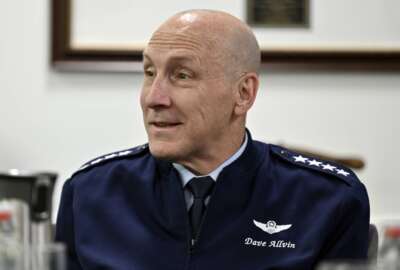Air Force launches provisional Integrated Capabilities Command
Along with the new command, the service stood up the Integrated Development Office as part of its sweeping set of plans announced in February.
When Air Force Secretary Frank Kendall unveiled a ‘sweeping’ set of force structure changes in February, one of the biggest shakeups announced was the creation of a new Integrated Capabilities Command. Seven months later, the service introduced a provisional version of the command, which will play a crucial role in centralizing the planning process for the service’s future requirements and capabilities.
The new Integrated Capabilities Command is similar to other major commands and will be led by a three-star commander once it reaches its full operational capability. The goal is to allow other command centers to focus on daily operations rather than independently determining their own requirements or planning for the future.
Maj. Gen. Mark Mitchum, who most recently served as a special assistant to Chief of Staff Gen. David Allvin, will lead the command. Allvin said the command will be fully operational in 2025.
The ICC will focus on:
- Generating requirements for new technologies and systems to stay ahead of emerging threats;
- Providing a demand signal to industry about the Air Force’s future needs;
- Wargaming operational concepts to develop capabilities that prioritize a system-of-systems approach;
- Creating different models for how the Air Force could organize its forces in the future with variable trade-offs and risks to inform the service’s funding decisions.
Allvin said there are currently 100 personnel assigned to the command — they remain at their current positions and locations but are “merging together” under the leadership of the ICC’s provisional commander. The goal is to have up to 800 people once the command fully matures.
“The thing about a provisional command is it doesn’t really have a manning document per se, but it really has a commander that oversees it, with personnel who remain at their current locations but are really matrixed in. I believe the end state is still somewhere around 750 to 800 — we’ll see as that evolves, but we’re doing a ramp-up approach. So what we expect this ICC provisional that’s coming into the fore right now, their first task to do is to be able to evaluate the way we’re modernizing our Air Force by core functions,” Allvin told reporters during AFA’s Air, Space & Cyber Conference.
“As we continue to evolve and continue to mature, the final number as to what responsibilities they will continue to take on, eventually, a strategic basing process that decides where the command is going to be will continue to mature along those lines. But we didn’t want to wait for all that to get started. So that’s what the provisional ICC is going to be doing now.”
Along with the provisional version of the new command, the service also appointed Gen. Duke Richardson to lead the Integrated Development Office, which is the first step toward establishing the office within the Air Force Materiel Command.
Richardson is now the service’s first capability development executive officer (CDEO) and will serve in a dual-hatted role. The service hasn’t named the IDO director as of yet, but Amanda Gentry, the Air Force Research Laboratory director of the sensors directorate, will serve as the IDO stand-up lead.
“The idea of the CDEO is that there is someone in the Air Force who is responsible for something the Air Force used to do but that we got away from, which is something called development planning. It’s basically saying we understand where we need to go with the force, and we’ve laid the foundation for how we’re going to get there. It’s not all the individual programs. It’s not program management, per se, because you aren’t at this stage of the game. You aren’t executing a program. You’re laying the foundation,” Andrew Hunter, the assistant secretary of the Air Force for acquisition, technology and logistics, told reporters.
“What do I mean by the foundation? It’s things like technical architectures, government reference architecture. How does the GPS constellation work? It has the technical architecture around it that informs not only the satellites but all the user equipment that is on not only all our military assets but on a lot of commercial civilian assets, as well as all architecture around GPS. So development planning is laying the technical foundation for that, and there’s a lot of other things besides technical architectures in it, but that is the job of the Integrated Development Office. It’s what we’re creating the Integrated Development Office to do, and it will drive integration into the force by baking it in on the front end.”
The new command, along with the IDO, will “establish partnership between the requirements and acquisition communities.” The office will have up to 200 staff mainly sourced from the Air Force Materiel Command.
Copyright © 2025 Federal News Network. All rights reserved. This website is not intended for users located within the European Economic Area.




